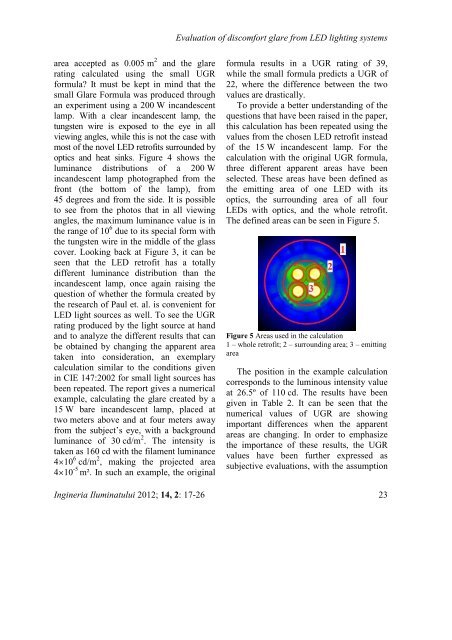Untitled - Journal of Lighting Engineering
Untitled - Journal of Lighting Engineering
Untitled - Journal of Lighting Engineering
You also want an ePaper? Increase the reach of your titles
YUMPU automatically turns print PDFs into web optimized ePapers that Google loves.
area accepted as 0.005 m 2 and the glare<br />
rating calculated using the small UGR<br />
formula? It must be kept in mind that the<br />
small Glare Formula was produced through<br />
an experiment using a 200 W incandescent<br />
lamp. With a clear incandescent lamp, the<br />
tungsten wire is exposed to the eye in all<br />
viewing angles, while this is not the case with<br />
most <strong>of</strong> the novel LED retr<strong>of</strong>its surrounded by<br />
optics and heat sinks. Figure 4 shows the<br />
luminance distributions <strong>of</strong> a 200 W<br />
incandescent lamp photographed from the<br />
front (the bottom <strong>of</strong> the lamp), from<br />
45 degrees and from the side. It is possible<br />
to see from the photos that in all viewing<br />
angles, the maximum luminance value is in<br />
the range <strong>of</strong> 10 6 due to its special form with<br />
the tungsten wire in the middle <strong>of</strong> the glass<br />
cover. Looking back at Figure 3, it can be<br />
seen that the LED retr<strong>of</strong>it has a totally<br />
different luminance distribution than the<br />
incandescent lamp, once again raising the<br />
question <strong>of</strong> whether the formula created by<br />
the research <strong>of</strong> Paul et. al. is convenient for<br />
LED light sources as well. To see the UGR<br />
rating produced by the light source at hand<br />
and to analyze the different results that can<br />
be obtained by changing the apparent area<br />
taken into consideration, an exemplary<br />
calculation similar to the conditions given<br />
in CIE 147:2002 for small light sources has<br />
been repeated. The report gives a numerical<br />
example, calculating the glare created by a<br />
15 W bare incandescent lamp, placed at<br />
two meters above and at four meters away<br />
from the subject’s eye, with a background<br />
luminance <strong>of</strong> 30 cd/m 2 . The intensity is<br />
taken as 160 cd with the filament luminance<br />
4 10 6 cd/m 2 , making the projected area<br />
4 10 -5 m². In such an example, the original<br />
Evaluation <strong>of</strong> discomfort glare from LED lighting systems<br />
formula results in a UGR rating <strong>of</strong> 39,<br />
while the small formula predicts a UGR <strong>of</strong><br />
22, where the difference between the two<br />
values are drastically.<br />
To provide a better understanding <strong>of</strong> the<br />
questions that have been raised in the paper,<br />
this calculation has been repeated using the<br />
values from the chosen LED retr<strong>of</strong>it instead<br />
<strong>of</strong> the 15 W incandescent lamp. For the<br />
calculation with the original UGR formula,<br />
three different apparent areas have been<br />
selected. These areas have been defined as<br />
the emitting area <strong>of</strong> one LED with its<br />
optics, the surrounding area <strong>of</strong> all four<br />
LEDs with optics, and the whole retr<strong>of</strong>it.<br />
The defined areas can be seen in Figure 5.<br />
Figure 5 Areas used in the calculation<br />
1 – whole retr<strong>of</strong>it; 2 – surrounding area; 3 – emitting<br />
area<br />
The position in the example calculation<br />
corresponds to the luminous intensity value<br />
at 26.5º <strong>of</strong> 110 cd. The results have been<br />
given in Table 2. It can be seen that the<br />
numerical values <strong>of</strong> UGR are showing<br />
important differences when the apparent<br />
areas are changing. In order to emphasize<br />
the importance <strong>of</strong> these results, the UGR<br />
values have been further expressed as<br />
subjective evaluations, with the assumption<br />
Ingineria Iluminatului 2012; 14, 2: 17-26 23
















